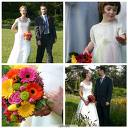
| Hundreds of colors and thousands of choices. Flowers may be simply be made up of carpels and stamens but last thing in the mind of a woman in preparing for her wedding day is simple. When the budget is available, an esteemed florist is attached to the decorating army not only for the chapel and the reception area but becomes key in adorning the bridal entourage, from the flower girl and ring bearer up to the bride and groom themselves. In nine out of ten weddings floral arrangements are table centerpieces and more often than not that these are complimentary to the bridal bouquet itself. Choosing the right flower is not always easy as its availability differs from country to country and is almost always season dependent. During the time of the ancient Greeks and Romans, the bride and groom wore garland on their necks to symbolize new life, hope and fertility. Women on the other hand, also carried bouquets but both of these were actually made not of flowers but of aromatic bunches of herbs and spices to ward off evil spirits. But during the momentous wedding of Queen Victoria to Prince Albert, these herbs and spices were mostly replaced with flowers, particularly Marigolds. Some herbs and spices were retained to fill the bouquet since were believed to increase sexual desire. During these times flowers soon became the secret language of lovers and each flower began having its own meanings. Historians even believe that in 17th century Turkey that lovers illicitly began using this “flower language” to convey actual messages. Soon enough this language was formally called of Florigraphy, which literally translates to the language of flowers. The type, color and shade including the combination of these were much like deliberate words used in a sentence. All this richly ensured the taking into tradition of the current use of flowers in the nuptial rites. Although modern women select their flowers for mostly their appealing color and shape to suit their specific personality and style, wedding flowers are still held as a symbol of grace and elegance at weddings. For westerners, the most popular flowers is use today are Roses, orchids and Calla Lily followed by Tulips, Gardenia, Hydrangeas, Lilac, Lily of the Valley, Stephanotis and the Ranunculus. Roses still symbolize love and passion, but its colors means purity (white), friendship (yellow), and desire/enthusiasm (orange) among others. Tulips symbolize fame at the same time also means “perfect lover but even the simple Daisy signifies loyal love, while the prized chrysanthemums are used are wedding anniversary gifts. Carnations represent pride and beauty and Daffodils means chivalry. In summary, the role of flowers in Weddings can be expanded from a mere decorative element to an additional carrier of a message from groom to the bride and the bride to her guests. Its visual appeal and at times its natural fragrance lift the height and drama of the event. Its symbolism, language and history at weddings continue to hold a promising flavor to the festivity from the sacramental, spiritual and to the social. Not only can most florists design centerpieces, floral accessories and bouquets but be also be consulted for the overall design theme of the event. Even if not locally available, experienced florists can actually import or find access to specialized flower producers and suppliers. By Timothy Spencer |










